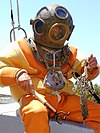Diving reflex
The mammalian diving reflex is a reflex in mammals which optimizes respiration to allow staying underwater for extended periods of time. It is exhibited strongly in aquatic mammals (seals,[1] otters, dolphins, etc.), but exists in a weaker version in other mammals, including humans.[citation needed] Diving birds, such as penguins, have a similar diving reflex. Every animal's diving reflex is triggered specifically by cold water contacting the face[2] – water that is warmer than 21 °C (70 °F) does not cause the reflex, and neither does submersion of body parts other than the face. Also, the reflex is always exhibited more dramatically, and thus can grant longer survival, in young individuals.
Effect
Upon initiation of the reflex, three changes happen to a body, in this order:
- Bradycardia is the first response to submersion. Immediately upon facial contact with cold water, the human heart rate slows down ten to twenty-five percent.[2] Seals experience changes that are even more dramatic, going from about 125 beats per minute to as low as 10 on an extended dive.[1][3] Slowing the heart rate lessens the need for bloodstream oxygen, leaving more to be used by other organs.
- Next, peripheral vasoconstriction sets in. When under high pressure induced by deep diving, capillaries in the extremities start closing off, stopping blood circulation to those areas. Note that vasoconstriction usually applies to arterioles, but in this case is completely an effect of the capillaries. Toes and fingers close off first, then hands and feet, and ultimately arms and legs stop allowing blood circulation, leaving more blood for use by the heart and brain. Human musculature accounts for only 12% of the body's total oxygen storage, and the body's muscles tend to suffer cramping during this phase. Aquatic mammals have as much as 25 to 30% of their oxygen storage in muscle, and thus they can keep working long after capillary blood supply is stopped.
- Last is the blood shift that occurs only during very deep dives. When this happens, organ and circulatory walls allow plasma/water to pass freely throughout the thoracic cavity, so its pressure stays constant and the organs aren't crushed. In this stage, the lungs' alveoli fill up with blood plasma, which is reabsorbed when the animal leaves the pressurized environment. This stage of the diving reflex has been observed in humans (such as world champion freediver Martin Štěpánek) during extremely deep (over 90 metres or 300 ft) freedives.
Thus, both a conscious and an unconscious person can survive longer without oxygen under cold water than in a comparable situation on dry land. Children tend to survive longer than adults when deprived of oxygen underwater. The exact mechanism for this effect has been debated and may be a result of brain cooling similar to the protective effects seen in patients treated with deep hypothermia.[4][5]
When the face is submerged, receptors that are sensitive to cold within the nasal cavity and other areas of the face supplied by cranial nerve V (trigeminal) relay the information to the brain and then innervate cranial nerve X (the vagus nerve), which is part of the autonomic nervous system. This causes bradycardia and peripheral vasoconstriction. Blood is removed from the limbs and all organs but the heart and the brain, creating a heart–brain circuit and allowing the mammal to conserve oxygen.
In humans, the mammalian diving reflex is not induced when limbs are introduced to cold water. Mild bradycardia is caused by subjects holding their breath without submerging the face within water.[4] When breathing with face submerged this causes a diving reflex which increases proportionally to decreasing water temperature.[2] Activating the diving reflex with cold water can be used to treat supraventricular tachycardia.[6] However the greatest bradycardia effect is induced when the subject is holding breath with face submerged.
Examples in fiction
- Lindsey Brigman in the James Cameron film The Abyss.
- Giacinta 'Jinx' Johnson in the James Bond film Die Another Day.
- A patient in Tachycardia on ER in Season 4
- Jack Buggit in The Shipping News by Annie Proulx
- "Starfish", 1999 by Peter Watts (author) ISBN 978-0-312-86855-0
- When DC Comics character The Question recovers from drowning, his survival is attributed to the diving reflex. "The Question" No. 2, Mar. 1987, written by Dennis O'Neil
See also
References
- ^ a b Zapol WM, Hill RD, Qvist J, Falke K, Schneider RC, Liggins GC, Hochachka PW (1989). "Arterial gas tensions and hemoglobin concentrations of the freely diving Weddell seal". Undersea Biomed Res. 16 (5): 363–73. PMID 2800051. Retrieved 2008-06-14.
{{cite journal}}: Unknown parameter|month=ignored (help)CS1 maint: multiple names: authors list (link) - ^ a b c Speck DF, Bruce DS (1978). "Effects of varying thermal and apneic conditions on the human diving reflex". Undersea Biomed Res. 5 (1): 9–14. PMID 636078. Retrieved 2008-06-14.
{{cite journal}}: Unknown parameter|month=ignored (help) - ^ Thornton SJ, Hochachka PW (2004). "Oxygen and the diving seal". Undersea Hyperb Med. 31 (1): 81–95. PMID 15233163. Retrieved 2008-06-14.
- ^ a b Lundgren, Claus EG; Ferrigno, Massimo (eds). (1985). "Physiology of Breath-hold Diving. 31st Undersea and Hyperbaric Medical Society Workshop". UHMS Publication Number 72(WS-BH)4-15-87. Undersea and Hyperbaric Medical Society. Retrieved 2009-04-16.
{{cite journal}}: Cite journal requires|journal=(help)CS1 maint: multiple names: authors list (link) - ^ Mackensen GB, McDonagh DL, Warner DS (2009). "Perioperative hypothermia: use and therapeutic implications". J. Neurotrauma. 26 (3): 342–58. doi:10.1089/neu.2008.0596. PMID 19231924.
{{cite journal}}:|access-date=requires|url=(help); Unknown parameter|month=ignored (help)CS1 maint: multiple names: authors list (link) - ^ Mathew PK (1981). "Diving reflex. Another method of treating paroxysmal supraventricular tachycardia". Arch. Intern. Med. 141 (1): 22–3. doi:10.1001/archinte.141.1.22. PMID 7447580.
{{cite journal}}: Unknown parameter|month=ignored (help)

